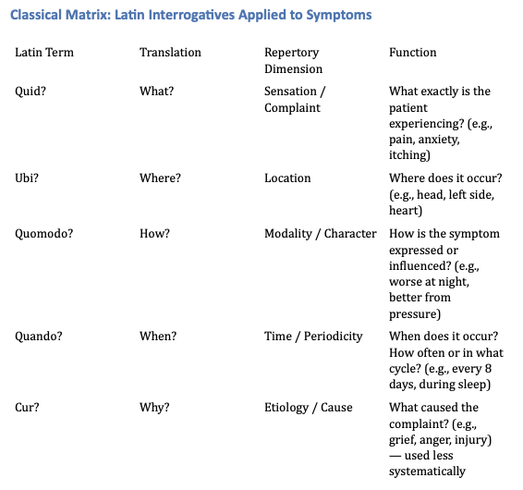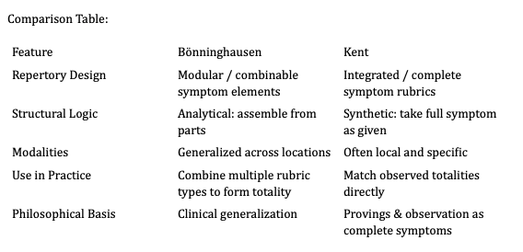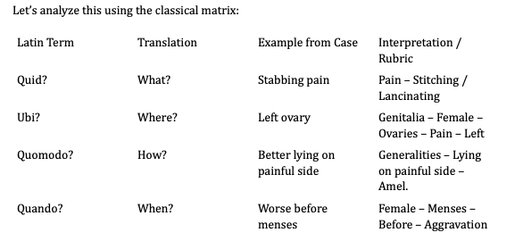


Bönninghausen’s “Quid, Ubi, Quomodo, Quando” Framework
A Foundational Structure in Homeopathic Repertorization
The Modular Strategy: Combinable Symptoms
Bönninghausen separated symptom components by type, allowing:
- Modalities to apply across multiple regions
- Locations to be linked with generalized sensations
- Time patterns to reinforce remedy confirmations
This enabled a combinatorial approach:
A practitioner could assemble a complete symptom by combining separate rubric parts, even if those parts did not occur together in a single proving.
This approach is highly synthetic, reproducible, and consistent with clinical confirmation logic, where remedies appear repeatedly under rubrics that form a symptom picture.
Influence on Kent’s Repertory
Kent’s Repertory of the Homeopathic Materia Medica is deeply indebted to Bönninghausen in terms of structure and symptom decomposition.
What Kent Adopted:
- The same categories: location (ubi), sensation (quid), modality (quomodo), and time (quando)
- The general sequence and organization of rubrics by anatomical regions
- A persistent emphasis on modalities and their high ranking in analysis
What Kent Changed:
- Integrated full symptom rubrics instead of separate modular parts
- Discouraged mechanical combination of rubrics unless they were observed and confirmed together
- Emphasized individualized totality over generalized patterns
Legacy and Relevance Today
Modern repertories such as Complete Repertory, Synthesis, and others integrate both approaches:
- Maintain Kent’s full symptom structure
- Allow cross-sectional analysis in the spirit of Bönninghausen
- Reintroduce modular elements through digital search and analysis tools
In the Complete Repertory (e.g., Curar), this dual perspective remains vital:
- For traceability (understanding origin and grading)
- For clinical accuracy (linking confirmatory cases)
- For flexible analysis (adapting to various case presentations)
Clinical Case Example: Demonstrating Quid, Ubi, Quomodo, Quando
The following case illustrates the application of Bönninghausen’s dimensions in clinical homeopathic analysis:
A 35-year-old woman presents with the following chief complaint:
“I have a stabbing pain in my left ovary that gets worse before my menses and is relieved by lying on the painful side.”
By decomposing the symptomatology along these four axes, a repertorist can assemble a precise totality even if the complete symptom does not exist as such in the proving. In this case, a remedy like *Lachesis* or *Lilium tigrinum* might surface prominently through their recurrence across these rubrics.
This method respects the individuality of the case while applying reproducible logic.
greetings, Roger van Zandvoort


Add comment
Comments